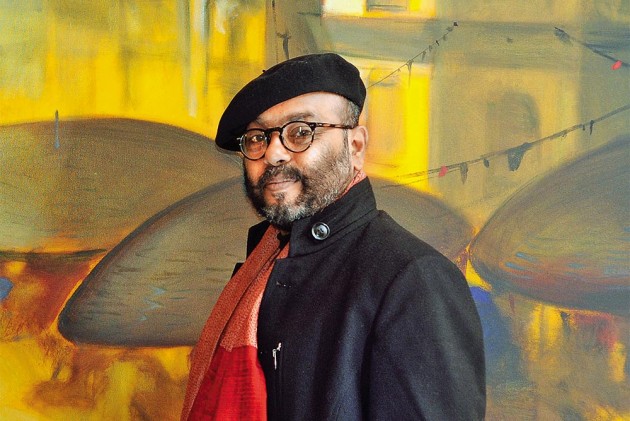Paresh Maity is one of India’s best known living artists. He knows how to place color, how to build surface and how to arrange a picture and he has changed the way many people in India expect a picture to look. He started with watercolors more than forty years ago and later added big oil paintings, metal and wood sculptures and room sized installations. Bright paint and clear stories run through every new group of works and they carry the look and feel of many Indian places and ways of life out to viewers around the world. Because of that steady output, his name now sits high on any list of important Indian artists who work this day.
Early Influences and Formative Years
Born in 1965 in Tamluk, a small town in West Bengal, Paresh Maity felt the wish to draw and paint while he was still a child. The rivers the fields, the local fairs and the normal routines of village life in Bengal stayed in his mind and later turned into the subjects of his art. He first learned his skills at the Government College of Art besides Craft in Kolkata and afterward he moved to the Delhi College of Art – during those student years he found the visual voice that people now recognise as his own.
During the first part of his career, Paresh Maity used watercolour almost every day – he painted quiet stretches of land and water and he showed small, ordinary events – a boat tied to a post, a boy walking home at dusk – without adding drama. Each picture was built on careful looking – he noted how pale winter light lies on a river, how a red festival flag stands out against grey sky and he put those facts on paper in quick, sure strokes. Viewers felt calm or nostalgic when they stood in front of the paintings, because the colours but also the empty spaces reminded them of their own memories.
After some years Maity set aside the tight, realist manner – he still began with a scene he had watched, but he let the shapes loosen, the colours grow louder and the outlines break apart. A group of boats became a single black arch – a line of trees turned into a sweep of vermilion. The aim was no longer to show exactly how a place looked – the aim was to show how it felt to stand in that place and what it meant to him inside.
Transition and Evolution of Style
Paresh Maity began with thin watercolor washes and later filled huge cloths with thick paint. The change gave him room to paint what his eye sees and what his heart feels. His pictures set people against broad shapes. Lemon, cobalt and flame backdrops lift private moods into plain sight. A single canvas feels like a stopped flash of dance, song or quiet thought.
Each tint carries a private meaning. The reds yellows, blues and oranges speak in place of words letting any watcher grasp the message. Critics call the outcome “poetry built from color”; it keeps old Indian pulse alive while speaking in today’s voice.
Themes and Inspirations
Paresh Maity keeps returning to three simple interests – people, journeys and the spots he reaches. Trips through India and foreign lands give him material that never runs out. On canvas Venice, Varanasi besides Rajasthan reappear as blocks of color that tell the story of each city and also reveal what moved the painter at the time.
Water shows up again but also again because, for him, it stands for life, for things that do not break and for every feeling in between. In the monsoon set of pictures, rain is not weather – it stands for new energy and for memories that refuse to leave. The same direct aim guides the faces as well as full-length figures he paints – love, the ache of distance being alone and sudden delight all appear through clear shapes and loud color.
Paresh Maity and Indian Modernism
In the story of Indian modernism, Paresh Maity stands where old custom meets new thought. He keeps the look and feel of Indian art – yet his pictures speak to people everywhere. He mixes Indian moods with the clean shapes of modern art and he shows how India keeps changing.
His pictures salute many voices – village songs, feast day colours, the loud pulse of daily life. At the same time he borrows fresh tools and talks with artists beyond India. The blend lets viewers at home and abroad recognise themselves in the work and it sends him out as a quiet envoy for art that comes from India this day.
Multidimensional Creativity
Besides painting Paresh Maity works with sculpture, installation and mixed media. He never settles on one style – he keeps changing materials and methods. At Indira Gandhi International Airport in New Delhi he painted a single wall that runs eight hundred and fifty feet, one of the longest murals anywhere.
Works of that size bring art out of museums but also into daily paths – he sets lights, color and story in one place so that people feel surrounded by the piece – the wall and the passer by stop being separate things. By building objects and spaces instead of flat pictures, he keeps stretching what modern art is allowed to be.
Recognition and Global Presence
Paresh Maity’s place in today’s Indian art scene is firmly established – people in India and far beyond speak of him with respect. He has staged more than eighty one man shows, in cities that stretch from London besides Singapore to New York and Hong Kong. Major museums public galleries and private homes on every continent now own his pictures.
In 2014 the Government of India gave him the Padma Shri, a top civilian award, for the weight his work carries in the country’s cultural story. Writers who cover art and people who buy it single out the way he uses color and shape to stir feeling and they note that the voice in his paintings stays his own, year after year.
Exhibition halls have guided the public through the stages of Maity’s career. ArtAliveGallery has taken the lead placing his canvases before viewers and buyers who respond to their bright color and to the roots they keep in Indian life. Each show the gallery mounts underlines how sure his hand is and how strongly his vision has steered recent Indian painting.
Impact on Future Generations
Paresh Maity does more than paint pictures – he shows younger artists how to test new ideas, speak plainly about feelings and stay proud of their own culture. He proves that a picture can speak of one village and also speak to the whole world, keep old memories alive and still point ahead. He holds on to the place he came from – yet talks about things every person understands and because of this the way Indian art looks and feels today owes something to him.
When people stand in front of his paintings they taste joy, remember old days and look inside themselves. They see the world not only as it appears, but as the heart records it. That strong tug of feeling keeps Maity’s place in Indian art fresh, long after the paint dries.
Conclusion
Paresh Maity began life in a small Bengal village and, step by step, turned himself into an artist known far beyond India. He kept painting never stopped trying new ideas and slowly changed the way people see Indian art this day. He knows how to place color, how to build shape and how to show feeling and that knowledge still moves young painters and viewers on every continent.
He fills his pictures with the look and mood of India, keeps the country’s stories alive and at the same time shows them to the rest of the world. Because of that people now count him among the artists who mark our era.



